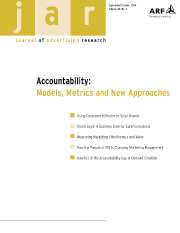Crossref Citations
This article has been cited by the following publications. This list is generated based on data provided by Crossref.
Grimes, Anthony
and
Kitchen, Philip J.
2007.
Researching Mere Exposure Effects to Advertising - Theoretical Foundations and Methodological Implications.
International Journal of Market Research,
Vol. 49,
Issue. 2,
p.
191.
Kim,Kunbae
and
전홍식
2009.
The Validity and Effectiveness of Copy Testing.
The e-Business Studies,
Vol. 10,
Issue. 5,
p.
145.
Korotkov, Nikolay Y.
2011.
Advertising Pre-Testing in Simulated Test Marketing.
SSRN Electronic Journal,
Jerman, Damjana
and
Završnik, Bruno
2013.
The Impact of Marketing Communications On Customer’s Response.
SSRN Electronic Journal,
Panigyrakis, George G.
and
Kyrousi, Antigone G.
2015.
Color effects in print advertising: a research update (1985-2012).
Corporate Communications: An International Journal,
Vol. 20,
Issue. 3,
p.
233.
Schlütz, Daniela
2016.
Handbuch Werbeforschung.
p.
547.


